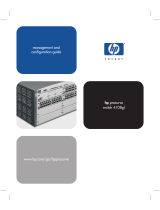
Hewlett-Packard Company
8000 Foothills Boulevard, m/s 5551
Roseville, California 95747-5551
www.procurve.com
© Copyright 2009 Hewlett-Packard Development Company,
L.P. The information contained herein is subject to change with-
out notice. All Rights Reserved.
This document contains proprietary information, which is
protected by copyright. No part of this document may be
photocopied, reproduced, or translated into another
language without the prior written consent of Hewlett-
Packard.
Publication Number
5992-5524
August 2009
Applicable Products
HP ProCurve Switch 6120G/XG (498358-B21)
HP ProCurve Switch 6120XG (516733-B21)
Trademark Credits
Microsoft, Windows, and Microsoft Windows NT are US
registered trademarks of Microsoft Corporation.
Disclaimer
The information contained in this document is subject to
change without notice.
HEWLETT-PACKARD COMPANY MAKES NO WARRANTY
OF ANY KIND WITH REGARD TO THIS MATERIAL,
INCLUDING, BUT NOT LIMITED TO, THE IMPLIED
WARRANTIES OF MERCHANTABILITY AND FITNESS
FOR A PARTICULAR PURPOSE. Hewlett-Packard shall not
be liable for errors contained herein or for incidental or
consequential damages in connection with the furnishing,
performance, or use of this material.
The only warranties for HP products and services are set
forth in the express warranty statements accompanying
such products and services. Nothing herein should be
construed as constituting an additional warranty. HP shall
not be liable for technical or editorial errors or omissions
contained herein.
Hewlett-Packard assumes no responsibility for the use or
reliability of its software on equipment that is not furnished
by Hewlett-Packard.
Warranty
See the Customer Support/Warranty information at
http://www.hp.com/#Support
.
A copy of the specific warranty terms applicable to your
Hewlett-Packard products and replacement parts can be
obtained from your HP Sales and Service Office or
authorized dealer.
HP Contact Information
For the name of the nearest HP authorized reseller:
• See the Contact HP worldwide (in English) webpage
(http://welcome.hp.com/country/us/en/wwcontact.html).
For HP technical support:
• In the United States, for contact options see the Contact
HP United States webpage
(http://welcome.hp.com/country/us/en/contact_us.html).
To contact HP by phone:
• Call 1-800-HP-INVENT (1-800-474-6836). This service is
available 24 hours a day, 7 days a week. For continuous
quality improvement, calls may be recorded or monitored.
• If you have purchased a Care Pack (service upgrade),
call 1-800-633-3600. For more information about Care
Packs, refer to the HP website (http://www.hp.com/hps).
• In other locations, see the Contact HP worldwide (in
English) webpage
(http://welcome.hp.com/country/us/en/wwcontact.html).




















